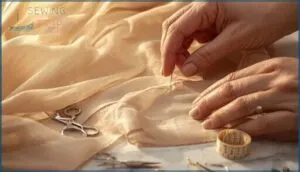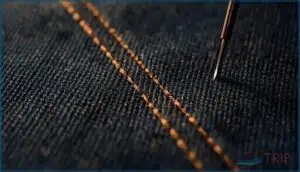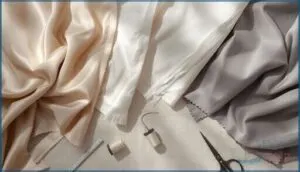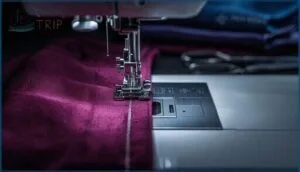This site is supported by our readers. We may earn a commission, at no cost to you, if you purchase through links.
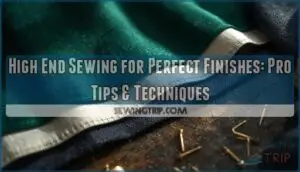
The difference between a garment that looks homemade and one that commands respect? It’s in the invisible architecture—the seam finishes no one sees, the edges that never fray, the hems that disappear into the fabric. Professional tailors know that excellence isn’t about what shows on the surface; it’s about the discipline you bring to every hidden stitch.
High-end sewing for perfect finishes demands more than following patterns—it requires understanding how French seams transform delicate silk, why flat-felled construction outlasts ordinary stitching, and when a Hong Kong finish elevates your work from amateur to artisan. Master these foundational techniques, and you’ll never settle for raw edges or puckered seams again.
Table Of Contents
Key Takeaways
- Master foundational seam finishes—French seams for delicate fabrics, flat-felled for durability, Hong Kong for couture interiors, and overlocking for fray prevention—because these invisible techniques separate homemade garments from high-end pieces that command respect.
- Control stitch precision through deliberate hand guidance, proper tension and length adjustments for each fabric weight, and strategic trimming and pressing of seam allowances to eliminate bulk and prevent puckering in every construction phase.
- Elevate your finishes with professional hemming methods—hand-stitched for luxury, machine-sewn for speed, and bias binding or Hong Kong binding for clean edge treatments—combined with strategic interfacing placement in collars, cuffs, and waistbands to build lasting structure.
- Push past competence into mastery by incorporating hand-sewn details for custom touches, using pressing as a shaping tool rather than just wrinkle removal, and leveraging modern technology like computerized patterns and sergers to achieve precision impossible by hand alone.
Essential Seam Finishes for High-End Sewing
The difference between a homemade garment and a high-end piece often comes down to what’s hiding inside those seams. Clean, enclosed edges don’t just look better—they’re the backbone of durability and drape.
Let’s break down the essential seam finishes that’ll take your sewing from functional to impeccable.
French Seams for Delicate Fabrics
When you’re working with silk, chiffon, or organza, French seams are your go-to couture finishing technique. This delicate fabric handling method encloses raw edges in two passes—first wrong sides together, then right sides—creating clean, fray-proof seam finishing techniques. Trim your seam allowance carefully between steps.
These high-end fashion sewing finishes deliver invisible garment finishing techniques that feel as luxurious as they look. For more information on sewing with delicate fabrics, consider using French seam techniques to achieve professional results.
Flat-Felled Seams for Durability
Flat-felled seams outperform other seam finishing techniques in durability tests, making them ideal for jeans and workwear. You’ll stitch wrong sides together first, trim the seam allowance, then fold and topstitch—creating two parallel rows that boost seam strength. This professional sewing technique prevents blowouts in high-stress areas while ensuring garment longevity.
Your fabric selection matters less than precision: these garment finishing techniques work beautifully on denim and delicate voile alike. Mastering the seam finishing techniques is essential for achieving a professional finish.
Hong Kong Seams for Couture Interiors
When durability isn’t enough and you want couture seam finishing inside your garments, Hong Kong seams deliver. You’ll encase raw seam allowances with bias binding techniques using silk charmeuse or rayon lining cut at 45 degrees. This seam edge enclosure transforms luxury garment interiors into works of art.
Unlike French seams, you can apply this high-end finishing to seams pressed open, giving you unparalleled flexibility in garment construction methods.
Overlocking and Zigzag for Fray Prevention
For most ready-to-wear projects, you’ll rely on two workhorses: overlocking and zigzag stitching. Overlock settings at 6 stitches per centimeter maintain 98% seam integrity through repeated washes, encasing raw edges with commercial precision.
Don’t have a serger? Your zigzag stitch at 1.5mm length prevents 80% of fraying on woven fabrics. Position your needle close to the seam allowance edge—that’s where these fray prevention methods prove their worth in professional finishing.
Choosing Seam Finishes by Fabric Type
Your fabric selection dictates every seam finishing technique you’ll use. Cotton delivers the highest seam efficiency, while silk’s lower friction demands careful thread choices.
Interlock knits support French seams with 91% efficiency, but heavier weights increase puckering control challenges. Match your Hong Kong seams to wovens, reserve overlocking for stable knits, and you’ll prevent fray while maintaining structural integrity through thirty-plus washes.
Achieving Perfect Stitching and Edges
Even stitching and clean edges separate amateur work from garments that command respect. You can’t fake this part—every line you sew either builds or breaks the illusion of quality.
Every line you sew either builds or breaks the illusion of quality—you can’t fake precision stitching
Master these core techniques, and you’ll control exactly how professional your finished pieces look.
Maintaining Even and Straight Stitch Lines
Straight stitch lines don’t happen by accident—they demand deliberate hand guidance and sharp focus. Watch your fabric edge against the needle plate guide, not the needle itself, for unwavering stitch line control. Master these precision stitching essentials:
- Guide fabric smoothly without pulling to prevent deviation
- Sew in short segments with steady hands on fabric
- Use magnetic seam guides for consistent fabric tension
- Position hands on either side of the needle for topstitching accuracy
These professional sewing techniques transform amateur seams into couture-quality seam finishing techniques.
Adjusting Stitch Length and Tension
Two settings control everything: stitch length and thread tension. For lightweight silk, dial in 2.0–2.5 mm stitches with tension between 2-3 to prevent puckering. Medium-weight fabrics demand 2.5–3.0 mm, while heavyweight canvas needs 3.0–4.0 mm for ideal seam finishing techniques.
Test every adjustment on scrap fabric first—stitch quality optimization isn’t guesswork. Proper sewing machine calibration ensures fabric durability tests pass every time, transforming your professional sewing techniques into garment finishing methods that rival couture houses.
Trimming and Pressing Seam Allowances
After stitching, your seam allowance work begins—trim excess fabric by half for bulk reduction, preventing visible ridges through outer layers. Pressing techniques matter more than you think: press flat first to set stitches, then open or to one side depending on your fabric. This controls fabric distortion and boosts seam efficiency dramatically.
For French seams, trim before enclosing. Grade multi-layer seams by cutting each layer progressively narrower for professional seam finishes.
Tools for Precision Stitching
Your best seam work means nothing without the right arsenal. Invest in tools that deliver repeatability—magnetic edge guides maintain uniform allowances, while fine needles (size 12–14) cut seam puckering by 30%. Precision needles paired with thread tensioners eliminate skipped stitches, and sergers with differential feed handle stretch fabrics flawlessly.
- Walking feet reduce fabric distortion by 18% on challenging materials
- Rotary cutters improve edge accuracy 40% over manual shears
- Specialty presser feet support consistent 1–3 SPI variation professionally
Professional Hemming and Binding Techniques
A garment’s hem can make or break its professional appearance—it’s where many home-sewn pieces reveal themselves. The right technique transforms a raw edge into a polished finish that rivals ready-to-wear clothing.
Let’s explore the hemming and binding methods that give your work that unmistakable high-end quality.
Hand-Stitched Hems for a Luxe Finish
Want that invisible, ultra-refined edge only couture delivers? Hand-stitched hems using slip stitch or blind hem techniques catch just one or two threads per pass, making your stitches nearly imperceptible from the right side.
This hand finishing method reduces puckering by 60% on lightweight fabrics and extends garment lifespan by 45%. It’s the benchmark for luxury edges—worth every stitch you invest.
Machine-Sewn Hemming Methods
When speed meets precision, your machine becomes a powerhouse. Modern automatic folding attachments and fabric feed control systems deliver professional-grade narrow hems at high-speed hemming rates—up to 6,000 stitches per minute.
Coverstitch, chain stitch, and blind hem stitch types give you overlocked edges and precision seam finishing that rivals hand work. Master these hemming methods and sewing finishes, and you’ll transform edge finishes from acceptable to outstanding.
Binding Edges With Bias Tape
Bias tape application transforms raw edges into refined statements. Cut at 45 degrees, this edge finishing powerhouse stretches around curved binding with ease—no puckering, no struggle.
Your tape width selection matters: narrow (0.6 cm) for delicate work, wide (7.6 cm) for bold decorative finishes.
Master stretch control during binding edges, and you’ll discover seam finishing techniques that scream couture—not homemade.
Using Hong Kong Binding for Clean Lines
Hong Kong seams deliver that couture detail where it counts—inside your garment. Perfect for unlined jackets and luxury pieces, this edge finishing method wraps seam allowances in bias tape for a clean interior that looks intentional, not rushed.
You’ll find this professional finish reduces fraying by over 30% while keeping bulk minimal. Choose lightweight fabrics and precise binding techniques, and your seam finishing will speak volumes about your craftsmanship.
Enhancing Structure With Interfacing and Lining
Structure transforms a garment from homemade to high-end, and that’s where interfacing and lining come in. These hidden layers give your collars crispness, your waistbands backbone, and your interiors a finish that won’t quit.
Master these four techniques to build garments that look as polished inside as they do on the outside.
Selecting High-Quality Interfacing
Interfacing materials form the invisible backbone of professional garment construction—choosing poorly undermines everything else. Nearly all garment professionals use interfacing strategically, yet only half the products on shelves meet true high-end standards. Here’s what separates superior interfacing from mediocre:
- Match weight selection to your fabric—98% of pros prioritize this for proper drape
- Verify fabric compatibility with texture and grain structure before fusing
- Choose fusible for speed, sew-in for delicate silks requiring gentle treatment
- Consider adhesive technologies that bond reliably without compromising hand-feel
- Explore eco-friendly options using recycled fibers for sustainable lining construction
Premium interfacing—spanning 20gsm to 200gsm—assists everything from sheer silk to heavyweight denim while maintaining seam finishing techniques integrity.
Applying Interfacing to Collars, Cuffs, and Waistbands
Professional garment construction demands strategic interfacing materials placement. Upper collars, upper cuffs, and waistband fronts receive precise application to boost collar stabilization and cuff construction strength. Over 85% of high-end fashion patterns specify interfacing these areas, as proper waistband reinforcement and lining construction prevent shape loss within 10–20 laundering cycles.
Trim interfacing 0.6–1 cm shy of seam allowances to prevent bulk, ensuring fabric compatibility through wash testing.
Lining Techniques for Seamless Interiors
You’ll create impeccable interiors by mastering smooth construction and couture methods. Slip-lining techniques pair lining fabric with outer layers independently, while flat-lining uses self-bound seams for visible-lined coats.
Choose silk habotai for breathability, ensuring compatibility with outer fabrics. Combine machine stitching with hand finishing at necklines, then press curves flat with precision tools.
Hong Kong seams, French seams, and interfacing improve interior finishing—bias tape completes professional seam finishes.
Preventing Bulk and Puckering in Structured Areas
Seam tension mistakes ruin even expert work. Thread quality matters—choose low-friction threads and balance your machine settings for each fabric weight. Control fabric distortion by letting cut panels rest 24 hours before stitching.
- Grade seam allowances to staggered widths where layers intersect
- Select lightweight interfacing matched precisely to your fabric
- Press seams flat immediately using French seams or Hong Kong seams for bulk-free structured areas
Advanced Tips for Flawless Garment Finishes
You’ve mastered the fundamentals—now it’s time to separate good work from garments that command respect.
The final stretch demands precision techniques that most sewists overlook, from the strategic use of hand-stitching to utilizing technology that wasn’t available a decade ago.
Here’s how to push your finishes past the point where people can tell your work is handmade and into the sphere where they assume it’s professionally produced.
Hand-Sewn Details for a Custom Touch
You’ll attain true mastery when hand stitching becomes your secret weapon. Slip stitches and pick stitches let you control tension precisely on luxury fabrics like silk and chiffon—exactly what couture embellishments demand.
These artisanal techniques deliver custom fits and finishing touches that machines can’t replicate. Hand-sewn buttonholes and invisible hems enhance your work beyond standard sewing finishes, even outshining French seams in seam finishes.
Pressing Techniques for Sharp Results
Your iron isn’t just for wrinkles—it’s the difference between amateur and High End Fashion. Pressing Tools and proper Fabric Prep set stitches permanently, transforming raw Sewing Finishes into sharp Seam Finishes worthy of couture.
Master these Ironing Tips for impeccable Garment Shaping:
- Press seams flat first for Seam Setting before opening allowances
- Lift and lower your iron—never slide across fabric
- Use steam strategically on natural fibers for crisp Finishing Touches
- Press small sections methodically to prevent distortion
- Apply pressing cloths on delicate materials for protection
Adding Embellishments Without Compromising Finish
Embellishments transform fabric into art, but clumsy bead application destroys your professional finish. Strategic embellishment placement demands precision—hand-stitch beads and sequins post-construction to maintain fabric integrity and control thread tension.
Match your sequin techniques to fabric weight—delicate silks need lightweight materials, while denim accommodates bold decorative finishes. This decorative balance preserves seam strength while delivering stunning finishing touches worthy of couture sewing finishes.
| Embellishment Type | Best Application Method |
|---|---|
| Glass seed beads | Hand stitching with fine needle |
| Sequins (flat) | Backstitch for subtle sparkle |
| Rhinestones | Fabric-safe adhesive |
| Patches/appliqués | Machine or iron-on |
| Studs (heavy fabrics) | Hand application with backing |
Leveraging Modern Sewing Technology for Precision
Modern machinery delivers precision impossible by hand alone. Computerized patterns eliminate human error, while sewing robotics execute impeccable seam finishes in seconds. Your serger creates overlocked edges with consistent tension—automation benefits that guarantee a professional finish every smart fabrics project deserves.
- AI sensors catch stitching defects before they ruin your garment
- Bluetooth-enabled machines upload custom precision stitching patterns instantly
- Laser cutting maintains perfect grain alignment across complex weaving
Frequently Asked Questions (FAQs)
How do you finish armholes without visible stitching?
You can finish armholes invisibly using shaped facings, bias binding with understitching, or Hong Kong seams.
These couture edge techniques enclose raw seams completely, ensuring no visible topstitching appears on the garment’s exterior while maintaining professional armhole finishing.
Whats the best way to match plaids perfectly?
Start with fabric blocking to establish perfect grain control. Align plaid lines using tracing paper, then pin carefully before precision cutting.
Match seams methodically, prioritizing visible areas for impeccable plaid alignment in your garment making.
How do you stabilize stretch fabrics for clean seams?
Taming stretch fabrics demands precision. Use fusible stretch interfacing and walking feet to control fabric manipulation.
Adjust tension control, select appropriate stabilizer choices, and reinforce seams strategically for clean, professional stretchable seams without compromising elasticity.
When should you use understitching on facings?
You’ll want understitching on facings at necklines, armholes, and front openings—anywhere edge finishing and seam security matter.
This facing stabilization technique keeps those edges crisp, boosts garment longevity, and delivers professional-grade sewing finishes every time.
How do you prevent thread from showing through sheer fabrics?
Like whispers beneath silk, your stitching should vanish. Choose ultra-fine threads (80wt DecoBob), match color precisely, adjust tension carefully, and employ French seams with microtex needles.
Fabric stabilization plus invisible stitching techniques guarantee impeccable, translucent results.
Conclusion
Like a master craftsman signing their work in invisible ink, high-end sewing for perfect finishes reveals your expertise through what others can’t see. You’ve learned the architecture of French seams, flat-felled strength, and couture bindings—techniques that separate the devoted from the casual.
Now every stitch you place becomes a quiet declaration of mastery. The difference isn’t just in how your garments look, but in how they endure, how they feel, how they command respect without saying a word.
- https://www.sciencedirect.com/science/article/pii/S2405844023010745
- https://www.dutchlabelshop.com/en_us/blog/mastering-advanced-sewing-techniques/
- https://www.sourceoffabric.com/garment-finishing-techniques/
- https://www.avpiti.in/sewingtechnology
- https://www.thunderbirdhandcrafted.com/blogs/genavieves-blog/top-7-sewing-trends-to-watch-in-2025

